The FA Women’s Super League is widely regarded as the most competitive league in women’s football. The WSL has been fully professional for a number of years now and is continuously attracting some of the biggest names in the women’s game.
Sam Kerr’s 2020 arrival has been widely considered something of a pivotal moment for both Chelsea and the league, one of the world’s most reputable stars making a move to the WSL. Thanks to significant investment from The FA and various television broadcast deals, the league has remained on an upward trajectory and that looks set to continue.
Since the success of Euro 2022, many more eyes have been on women’s football in England, and it has to be said, they are being treated to a four-team title race – something the WSL has never seen before. This analysis, which will take the form of a data analysis, will look to answer one hypothesis:
Can we use data to predict who will be crowned 2022/23 WSL champions?
By looking at the statistics and analysing the data, we should be able to predict who will be walking away with the trophy at the end of the season.
Previous WSL winners
Before we begin this data analysis, we need to ensure that we have a complete understanding of the previous winners of the FA Women’s Super League. This is important because there are other variables that we do need to factor into this data analysis, such as which teams know how to win. A team with a previous history of winning is more likely to know what it takes to get across the line.
The history of the FA WSL is one of growth, development, and progress. The league has come a long way since its inception in 2011, and it is now one of the most competitive and exciting women’s football leagues in the world.
Arsenal were the first team to ever be crowned WSL champions after winning the title in the inaugural campaign. The Gunners went on to win the league again in the second season before Liverpool claimed the title in the WSL’s third season. The Reds retained their title in 2014, while the following year saw Emma Hayes’ Chelsea team become champions of England for the first time.
Manchester City won their first title in 2016 after an impressive unbeaten season which saw them finish five points above Chelsea. The Blues came back fighting and won the 2017/18 title. This is the season where the WSL became a fully professional league, a huge step forward in the development of women’s football in England.
The following year saw The Gunners absolutely charge to the title, finishing seven points ahead of second-place Manchester City and scoring an incredible 70 goals in the process. Since 2019/20, in an incredible show of domestic dominance, it has to be said, Emma Hayes and Chelsea have won the title on three consecutive occasions.
The current campaign
The 2022/23 WSL season has been nothing short of spectacular, it has been the most competitive season to date. A statement that is endorsed by the fact that we have a four-horse title race in progress. Theoretically, Manchester United, Chelsea, Arsenal or Manchester City could be crowned champions.
Manchester United are currently top of the table with 41 points, Chelsea are hot on their heels though, just a single point behind and having played a game less. Meanwhile, Arsenal and Manchester City occupy third and fourth places but are both on 38 points, just three behind Marc Skinner’s side.
Manchester United
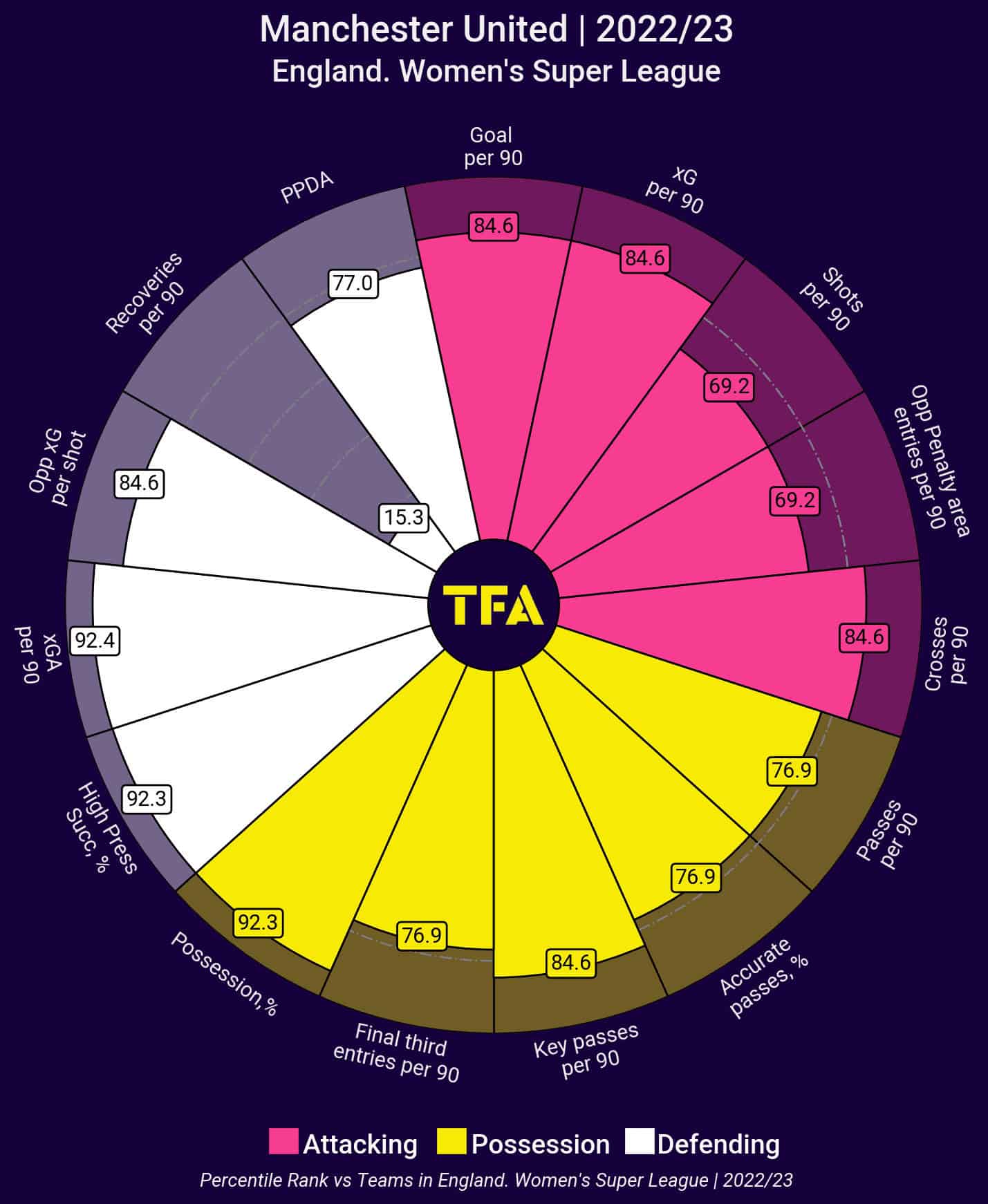
No one really expected Manchester United to be leading this title race. Many pundits and fans predicted a top-three finish so we can safely say they are performing above all expectations currently. The above pizza chart shows us Manchester United’s percentile ranks compared to their fellow WSL teams.
We can see that their percentile ranking for both goals per 90 and xG per 90 is exactly the same. From this, we can infer that The Red Devils are at least meeting their expected goals tally or bettering it. We can also see that they rank highly in terms of the number of crosses per 90 and of course, the percentile rankings for the high press and possession metrics are standouts. From this pizza chart, we can ascertain that Manchester United play a high-pressing, possession-based tactic that sees them create plenty of goalscoring opportunities from wide areas via the medium of crosses into the box.
Now, let’s take a closer look at Marc Skinner’s tactics and analyse the statistics to decide whether the WSL crown could be in Manchester United’s hands at the end of the current campaign.

According to Wyscout, we can determine that Skinner rarely wavers from his preferred 4-2-3-1 formation and as a result, Manchester United have become a rather cohesive unit. They average 62.72% possession per 90 which confirms what we gathered from the pizza chart. Interestingly, there have only been two occasions this season where United have had less than 50% possession in a game. Both games were against fellow title rivals, firstly in the defeat at home to Emma Hayes’ Chelsea and secondly, in the most recent Manchester derby.
The team from the red side of Manchester have picked up some key results over the course of the current campaign, a prime example being the last-gasp victory against Arsenal at the Emirates thanks to a late goal from Alessia Russo after withstanding some intense pressure from the home side.
Manchester United have been nothing short of clinical so far this season. They lead the WSL scoring charts averaging 2.71 goals per 90 and having netted 46 times so far from an xG of 38.76, with two of them coming from the penalty spot. Right back Ona Batlle makes absolutely pivotal contributions to the United attack. The Spaniard who looks set to leave Manchester in the summer has set up nine goals for her teammates so far this season. Her impending departure will leave a huge gap in this team that Marc Skinner will need to address if he wants to continue this upward trajectory of the club.
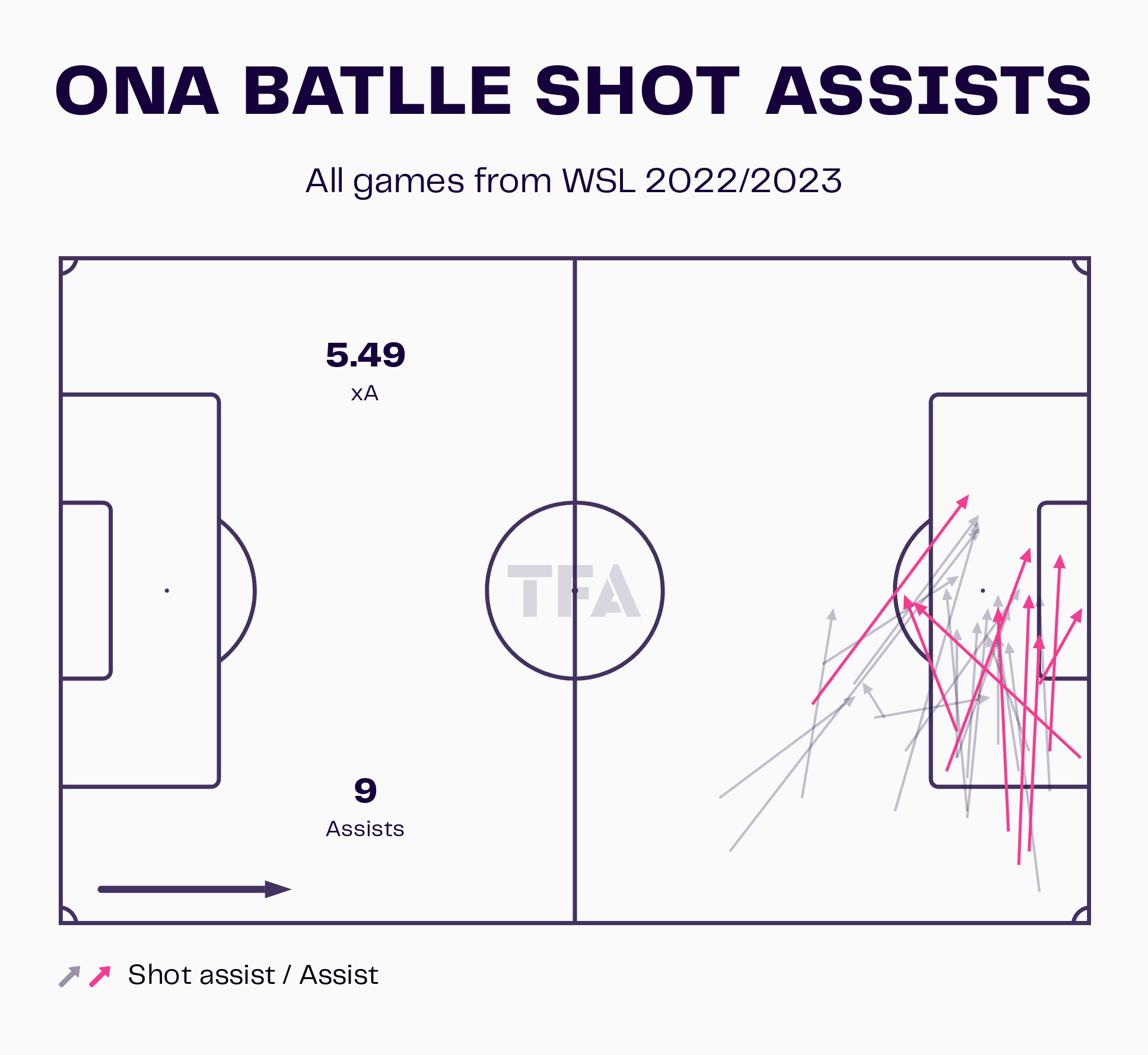
It’s also fair to say that Manchester United have an ideal centre-forward leading their line in the form of Alessia Russo. She does not only provide a goal-scoring threat, her off-the-ball movement means that she creates vast amounts of space for fellow attackers, such as Leah Galton who is having a stellar season herself. Moreover, Russo loves to work the channels, meaning she frequently looks to provide crosses into the box as we can see in figure 1.1.
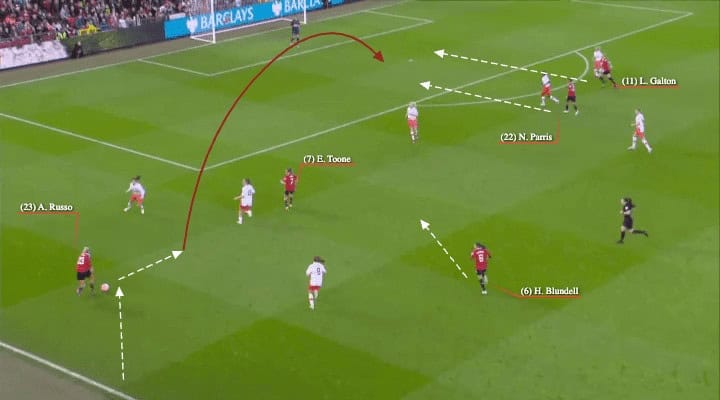

In addition to a very fluid attack, Marc Skinner will undoubtedly be elated that his team boast the best defence in the WSL having only conceded nine goals so far. If we assess the number of shots goalkeeper Mary Earps has faced this season with the number she faced last season, we can see that there is a significant improvement. So far, the England number one has faced an xG of 11.55 and prevented 2.55 goals whereas, over the entirety of last season, she faced 20.73 expected goals and conceded 0.27 more goals than expected. This shows that there has been a defensive improvement at Manchester United as the opposition are not receiving as many shooting opportunities. Moreover, the individual improvement in Mary Earps’ performances is clear to see as she is preventing a far higher number of goals than in the previous campaign.
Whilst Manchester United have been something of a surprise package this season, they show no signs of slowing down. However, they have two huge games coming up soon, the return fixture against Arsenal, who will most likely be out for revenge, and another Manchester derby. The results of those two games and the fact that Chelsea have currently played a game less will unquestionably have a huge impact on this title race.
Chelsea
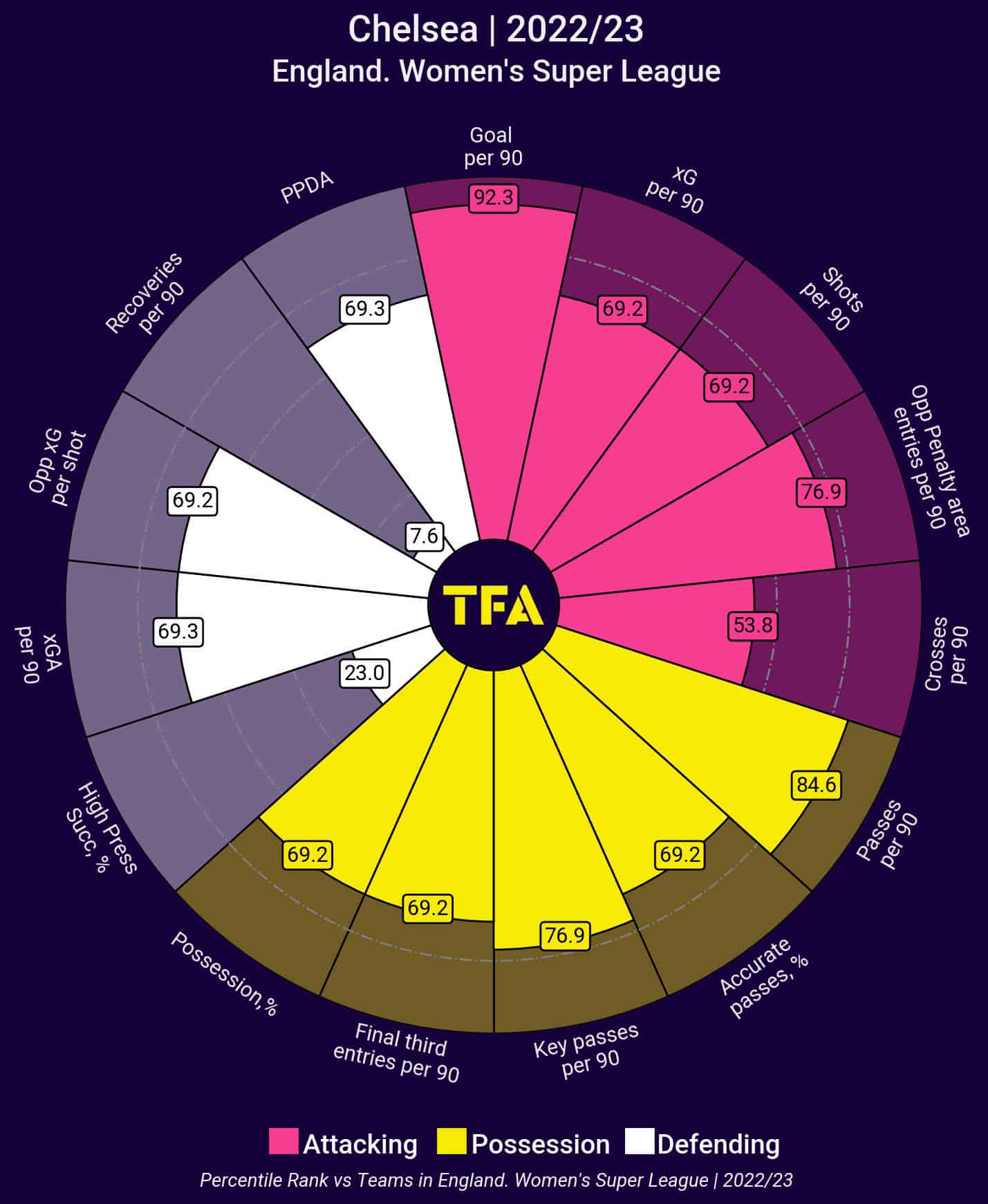
Let’s now turn our attention towards the defending champions, Chelsea. If we look at the pizza chart showing The Blues’ percentile rankings, we can see it differs vastly from that of Manchester United. Emma Hayes does ask her team to frequently press high but they understand that this is unsustainable throughout 90 minutes and are flexible with their press.
Sometimes they will look to allow the opponent to build up slightly before looking to regain possession in the midfield areas. Furthermore, they are also comfortable engaging in low block defending which has become a key element of their defensive play this season.
Of course, we cannot overlook Chelsea’s goals per 90, they are in the 93rd percentile according to the chart, which equates to an average of 2.63 goals per 90. However with Sam Kerr only having eight league goals to her name so far this season, Chelsea have had to turn to other players to ensure that the goals continue to flow.

As we can see from the graphic above, Chelsea’s tactics have been very interchangeable throughout the season. They have mostly utilised a 4-2-3-1 and a 4-3-3 formation while on occasions they will switch to a three-at-the-back system or a 4-4-2/ 4-4-1-1.
During the summer window, Chelsea made six signings, five of which could be classed as ‘first team’ players. This presented Emma Hayes with a conundrum as to what her strongest formation and lineup are, hence why there were a lot of tactical changes during the first few weeks of the season. More recently, Hayes looks to use the 4-2-3-1 and 4-3-3, suggesting she has now settled on these as her preferred tactical formations.

The Chelsea press is incredibly key to their rather relentless attack. As we can see in figure 2.1, The Blues have turned over possession and as Aston Villa look to launch a counterattack, Kadeisha Buchanan moves to immediately counterpress Rachel Daly, leaving her no option to play backwards.
Emma Hayes’ team allow their opponents to complete 8.44 passes per defensive action (PPDA) which shows their press is effective. However, this number is lower than Manchester United whose PPDA is 6.48. Chelsea also average 4.57 passes per possession indicating how they like to regain possession and attack swiftly and effectively.
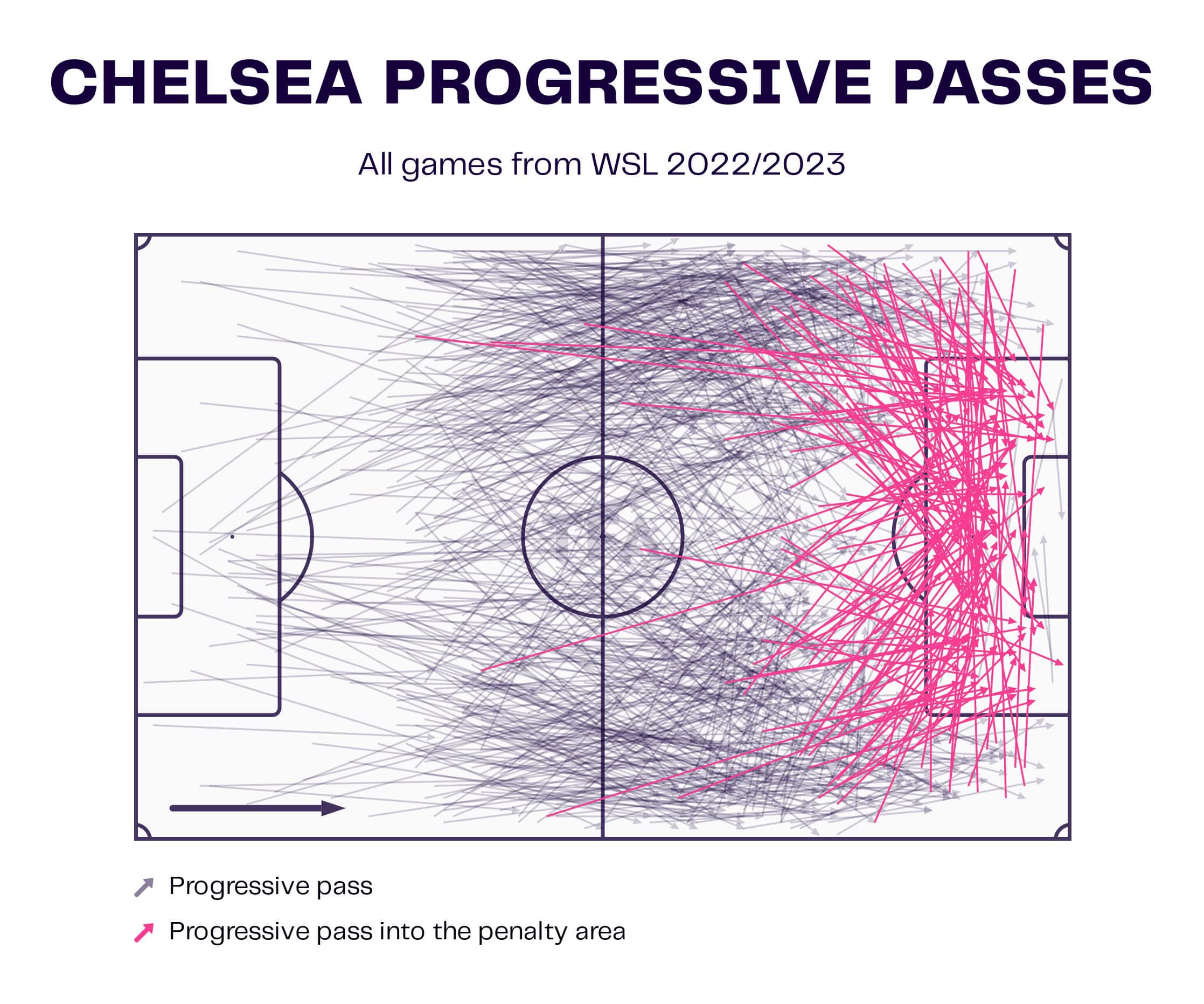
The defending champions top the progressive passes chart, averaging 87.31 per 90 which is significantly higher than the league average of 66.88. From this statistic, we can understand that when they are in possession, Chelsea are always looking to be progressive with it. The data viz above shows us the location of their progressive passes. We can clearly see that the majority of them are out to the wide areas and then into the penalty area.
Chelsea not scared of launching the ball long if necessary as they average 49.8 long passes per 90 – this provides them with the opportunity to rapidly transition from defence to attack and play Sam Kerr in behind the opposition defensive line.
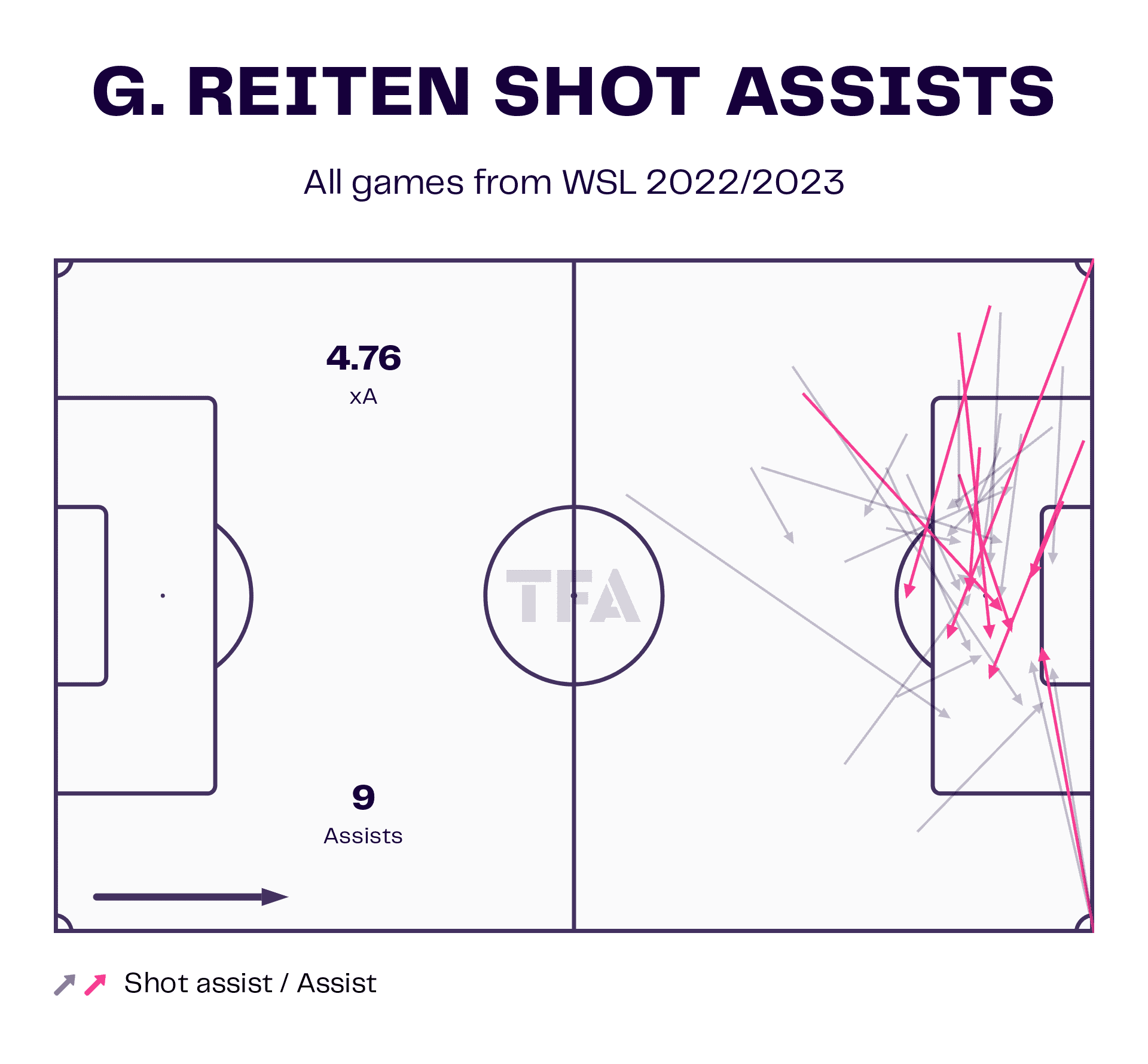
One player that has been absolutely integral to Chelsea this season is Guro Reiten. The Norwegian international leads the WSL assist charts with nine, meaning she averages 0.73 assists per 90. As we can see from the data visual above, Reiten’s nine assists have occurred from 4.76 expected assists. This number is of course influenced by the fact that Reiten does take set pieces for Chelsea. We can also see that the majority of her shot assists stem from the left wing, indicating that Chelsea like to maintain the width of the pitch to ensure there are plenty of opportunities to progress the ball into the box.
Given that Chelsea have played one game less than Manchester United, it’s fair to say that they have the advantage in the title race. The only caveat is that they still have the opportunity to win the Champions League as they recently progressed to the semi-finals. The question is whether the chance of European glory will distract the defending champions from retaining their domestic title.
Arsenal
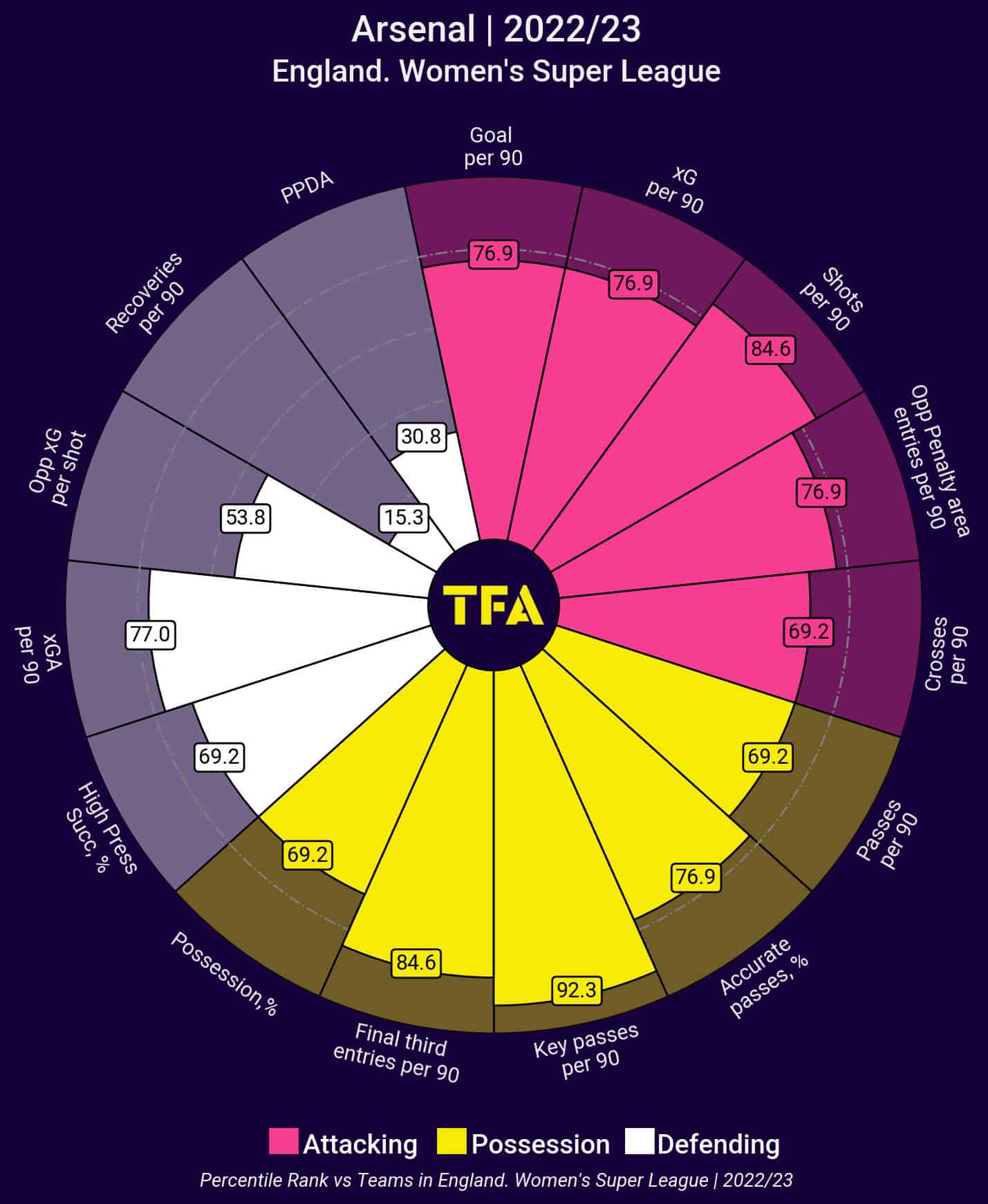
Next, we move on to the team in third place, Arsenal. The Gunners have endured a tumultuous season with star player Beth Mead suffering an ACL injury in the late defeat to Manchester United. Only a few weeks later, Vivianne Miedema suffered the same fate in a Champions League tie against Lyon.
If we look at the pizza chart above, we can see that Jonas Eidevall’s side rank highly in terms of key passes per 90. This means that Arsenal are very productive with their passing and frequently play passes that immediately generate goal-scoring opportunities. Arsenal averages 58.59% possession per 90, indicating a desire to play a possession-based style, in keeping with the ‘Arsenal DNA’ that runs throughout the club.

From the graphic above we can see that Jonas Eidevall heavily favours a 4-2-3-1 formation this season. This formation provides a solid defensive foundation by having two holding midfielders who can screen the back four and protect against counterattacks. The 4-2-3-1 is also effective when pressing high up the pitch, as the two holding midfielders can close down space in the centre of the pitch and cut off passing lanes, while the attacking midfielder can push up to create a front two, evolving the formation into a 4-4-2 while pressing.
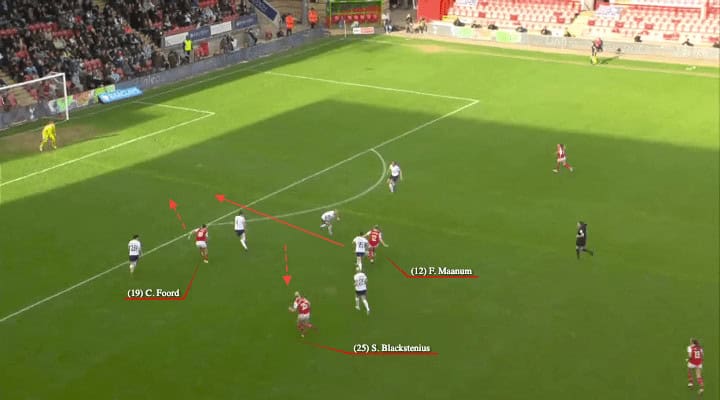
Stina Blackstenius now mostly operates as the number ‘9’ by Jonas Eidevall as he attempts to plug the gap left by the loss of Miedema. However, the Swede is a slightly different profile of player to the prolific goal scorer Miedema. As shown in figure 3.1, Blackstenius is more likely to drop deeper in order to retain or regain possession for Arsenal. Subsequently, this means that the likes of Foord (left winger) and Maanum (attacking midfielder) make more penetrating runs into the penalty area and thus contribute to more goals.
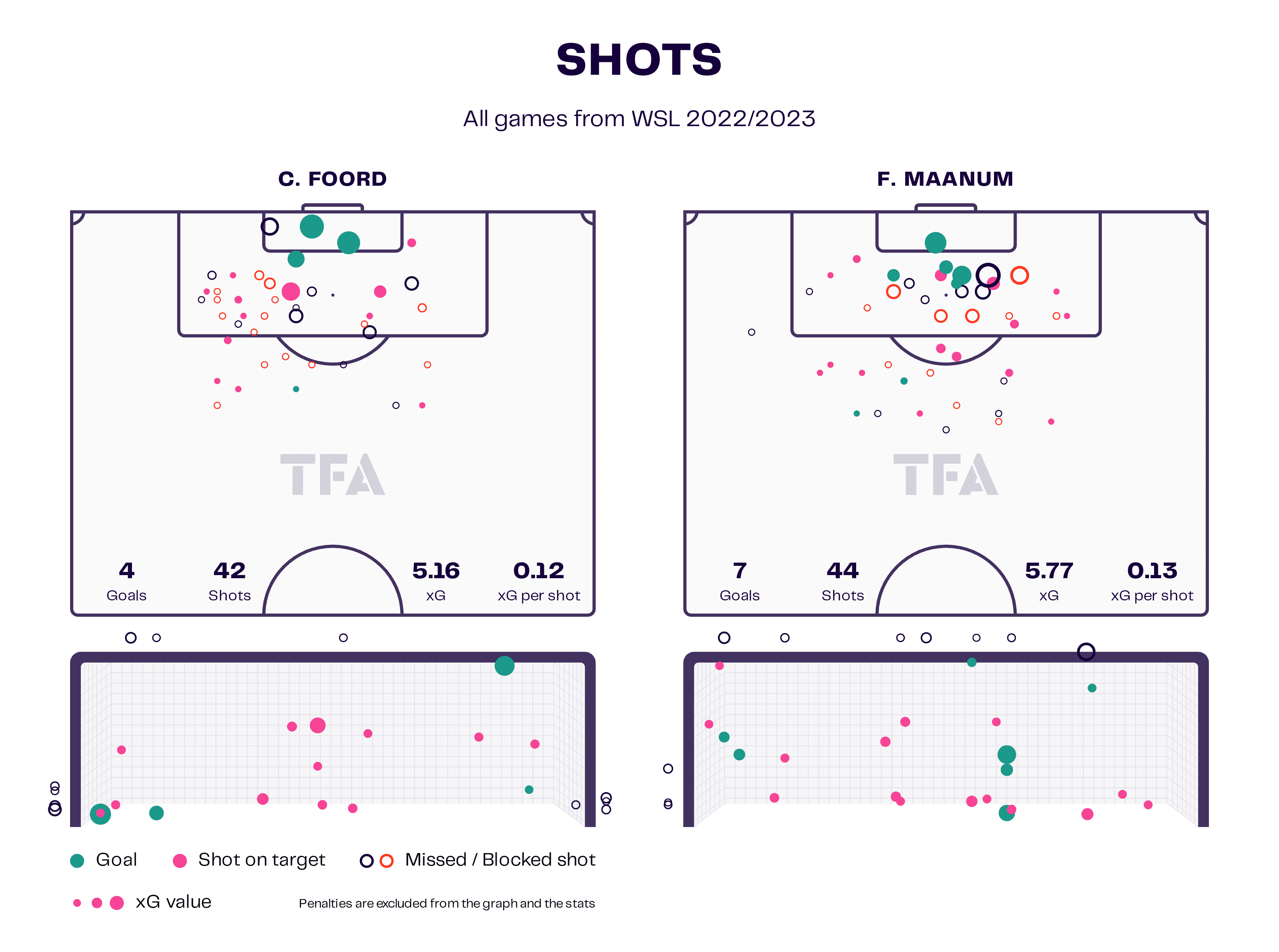
These shot maps show us the goal contributions of the aforementioned Foord and Maanum from the current campaign. Foord has already chipped in with four WSL goals this season which is equal to her tally from the entirety of the 2021/22 season. More impressively, Maanum found the net on three occasions last season. Currently, she has scored seven, this represents a significant increase and shows how she has stepped up when Arsenal needed her the most.
However, if we look into Arsenal’s goal-scoring abilities this season, the Continental Cup champions have scored 35 goals from an xG of 38.16 so we can confirm that they are underperforming in this metric. In contrast, as we saw earlier in this data analysis, league leaders Manchester United have scored 42 goals from an xG of 38.76.
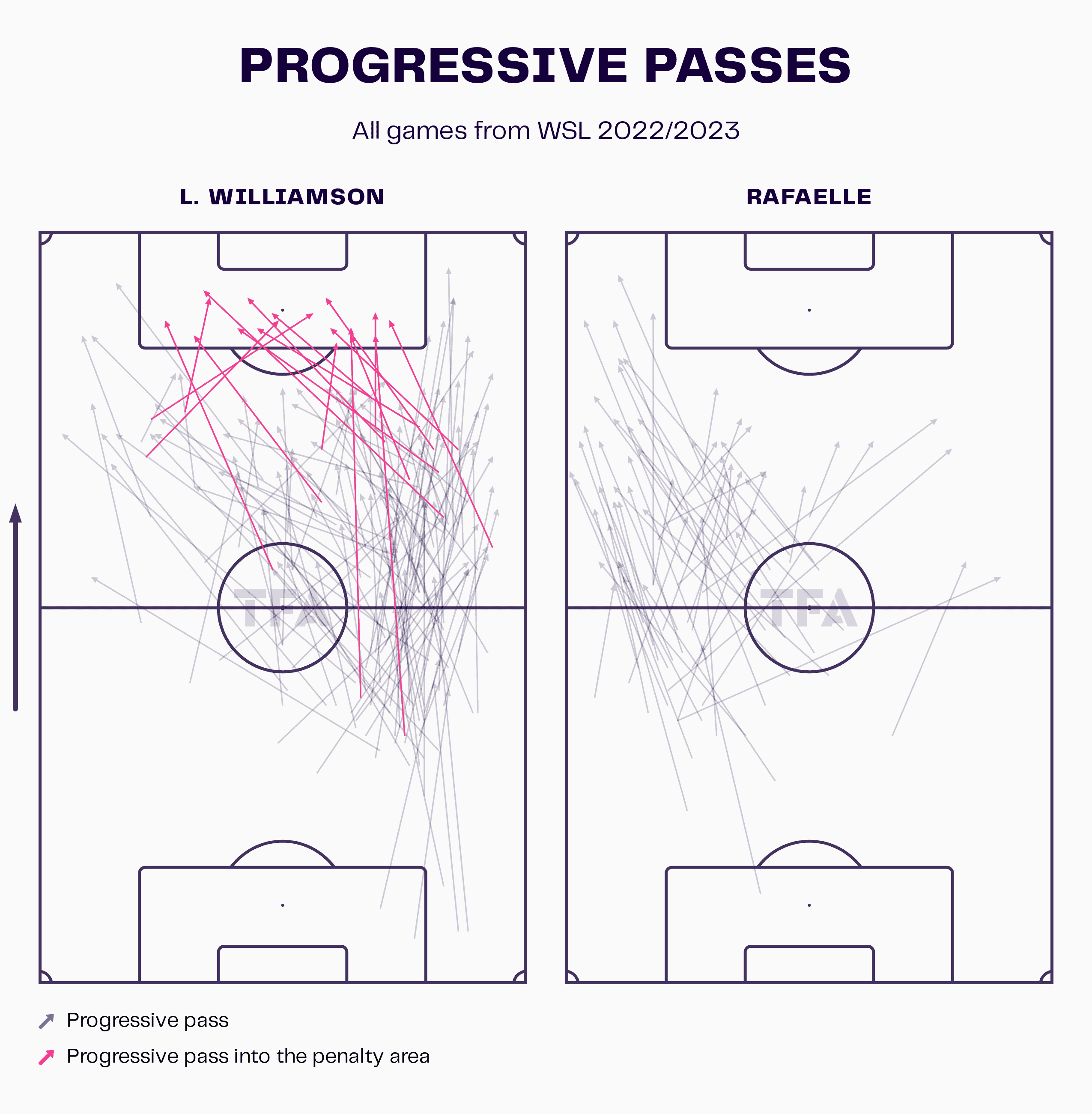
Arsenal have two of the best ball playing defenders in Leah Williamson and Rafaelle, both of which are key elements to The Gunners’ way of playing. As Jonas Eidevall looks to navigate a heavy fixture list and an injury crisis, he occasionally deploys Williamson as a midfielder due to her excellent abilities on the ball. The data visual shows us how the England captain in particular plays progressive passes through the lines and into the penalty area.
Furthermore, Arsenal boasts the second-best defence in the league having conceded only ten goals so far, second only to Manchester United. Goalkeeper Manuela Zinsberger has been integral to this as she has prevented 4.18 goals so far, proving why she is considered one of the best goalkeepers in women’s football. Whilst this demonstrates that Zinsberger has prevented more goals than Mary Earps, it also tells us that the Arsenal defence has conceded more goal-scoring opportunities – they have conceded an xG of 13.18 so far this season.
Arsenal have done incredibly well to bounce back from the injuries to key players and have found a way to continue to win. The penultimate game of the WSL season sees Arsenal head to Kingsmeadow to face Chelsea. This game could turn out to be incredibly important for the WSL title race. Should Arsenal lose this, there will be no way back. Additionally, given that they are currently three points behind Manchester United, even having played one game less, it appears the WSL title might just be beyond their grasp this season.
Manchester City
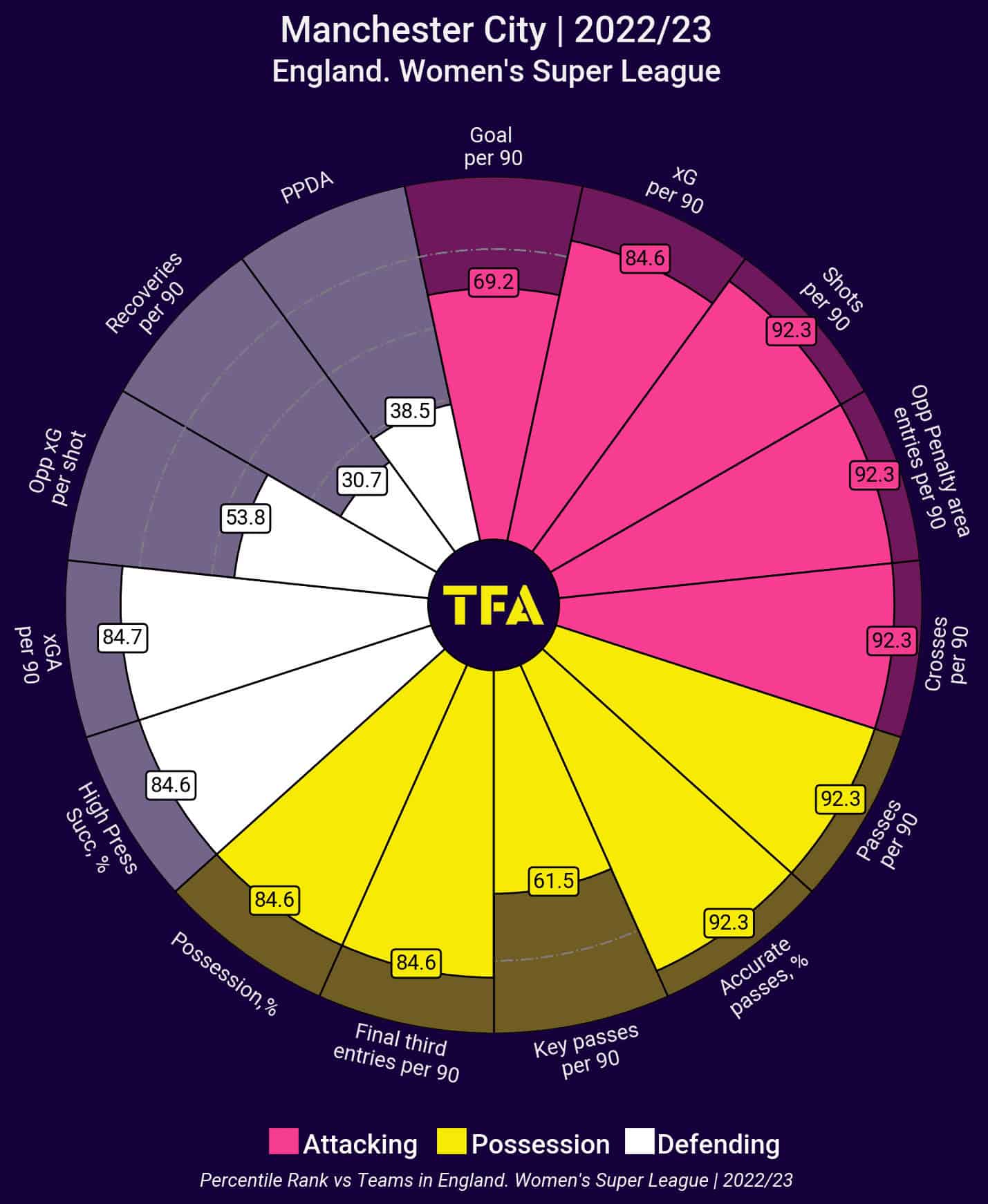
The fourth and final team in this WSL title race is Manchester City. Despite losing key players over the summer as Lucy Bronze, Georgia Stanway and Keira Walsh all departed the club, Gareth Taylor’s team have recovered remarkably well. As we can see from the pizza chart, similarly to Manchester United and Arsenal, Taylor likes his team to play possession football as they average 60.83% of the ball per 90.
It’s no surprise that Manchester City rank highly in terms of crosses per 90 as they have the speed of both Chloe Kelly and Lauren Hemp in the wide areas. It makes perfect sense for them to utilise this at every opportunity. There appears to be a very noticeable difference between Manchester City’s goals per 90 and expected goals per 90.

As we can see from the graphic above, Taylor favours a 4-3-3 formation. This is absolutely in keeping with his desire to predominantly focus attacking play in the wide areas. The 4-3-3 formation is a very attacking formation when used in a progressive manner. The three ‘forwards’ can stretch the opposition’s defence, whilst the midfielders can provide support and creativity in the attacking third. This tactical formation is highly effective in possession-based play, as the midfielders can provide a lot of passing options as well as having the forwards provide the width.
The Wyscout data available confirms the theory that Manchester City are underperforming their xG by quite a large margin. From an xG of 46.3, they have scored 35 times this season. Given the fairly large turnover of players that Manchester City saw throughout the summer, it is not unreasonable to suggest this underperformance may simply have been a result of teething problems whilst the group found some form of cohesion. More recently, Khadija Shaw has been nothing short of unstoppable, with 16 goals to her name, she is leading the WSL scoring charts by some distance.
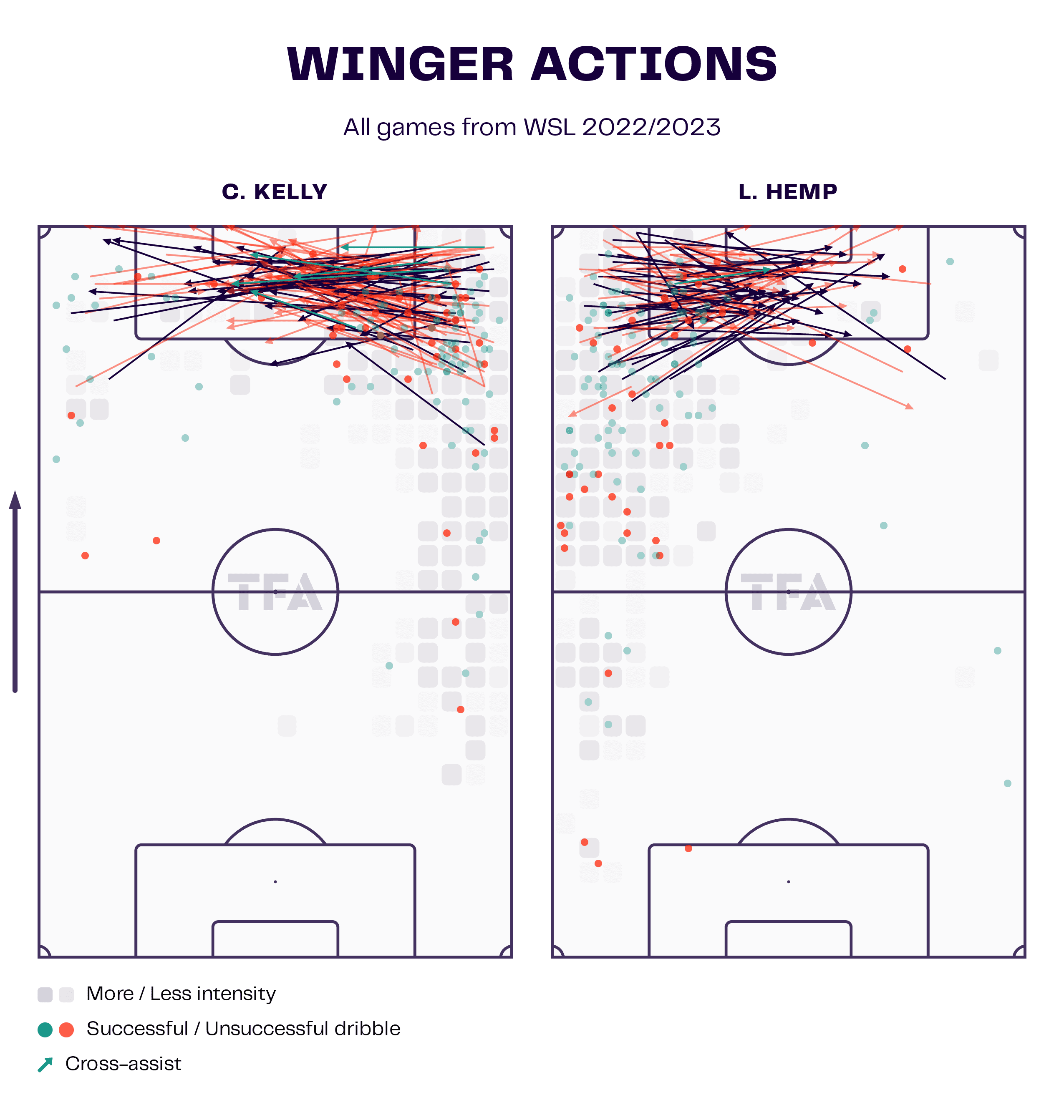
The data visual above demonstrates how frequently Manchester City look to use their wingers. Chloe Kelly has contributed five assists so far this season, although this does not see her in the top five of the assist table. Therefore, we can ascertain that City’s crossing is not always accurate. However, given that both Hemp and Kelly possess a great deal of pace, it is fair to say that utilising them is the best option for City to transition from defence to attack.
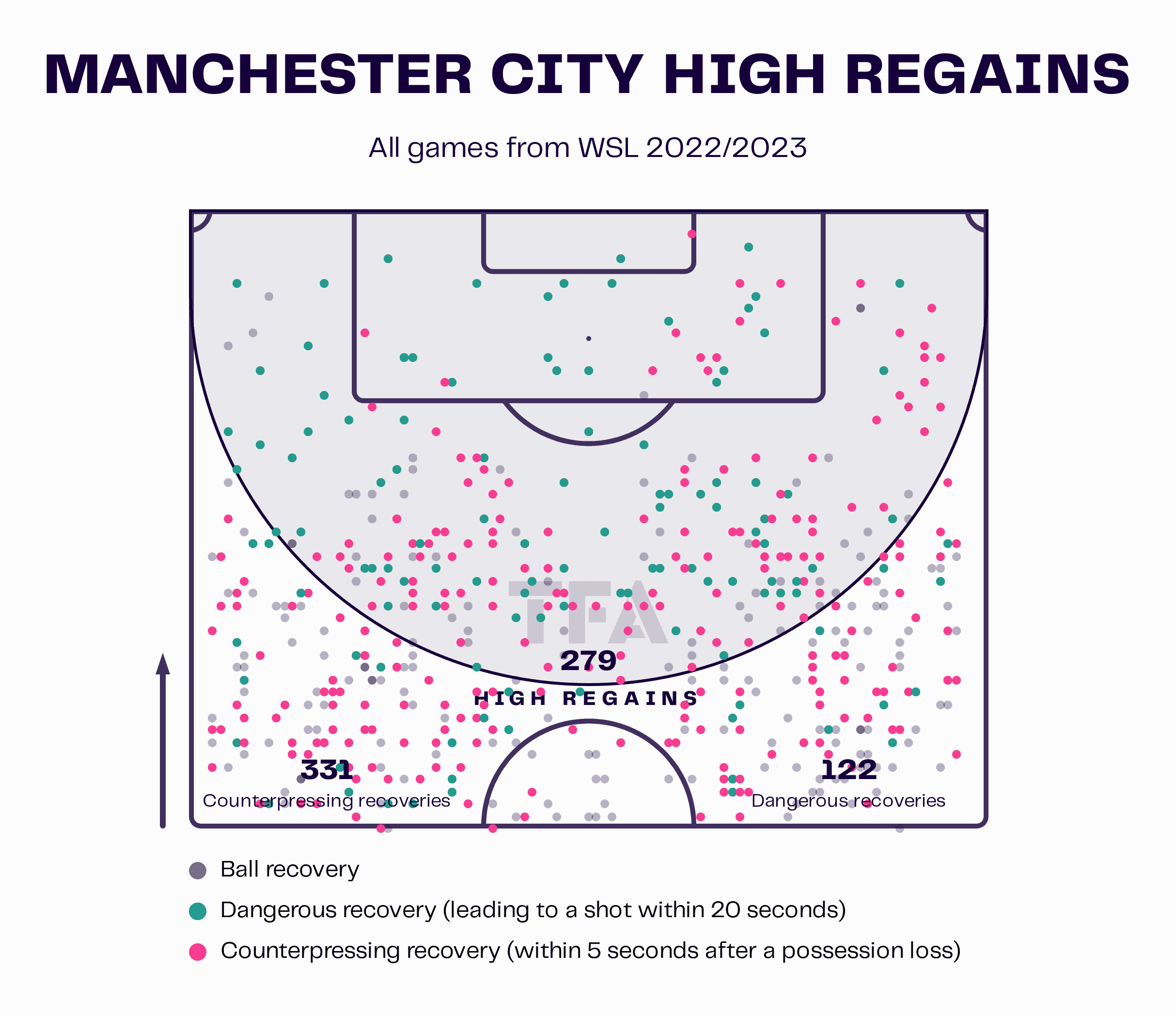
Whilst we have established that all the teams in this title race look to press high in order to regain possession quickly, it is Manchester City that are statistically the most effective at this. The team carry out Gareth Taylor’s desired pressing style extremely effectively. They win the ball back further up the pitch than any other WSL team with 279 high regains. This translates into 122 dangerous recoveries, meaning that the recovery of possession has led to a shot within 20 seconds.
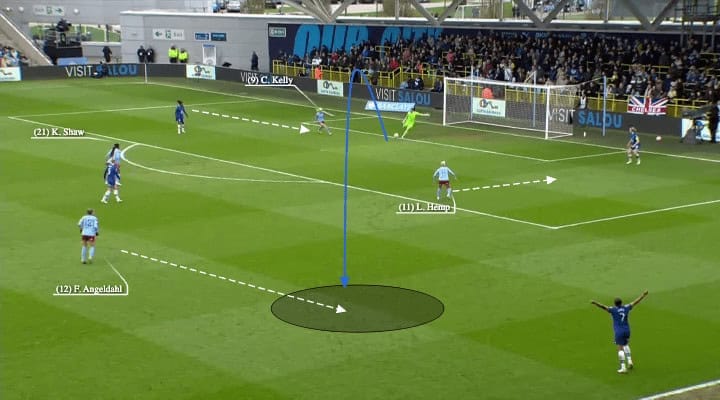
We can see the Manchester City counterpress in figure 4.1, taken from the recent game against Chelsea. Gareth Taylor’s side lost possession and as Chelsea played the ball back to the goalkeeper, Chloe Kelly initiated the counterpress. Meanwhile, Hemp Shaw and Angeldahl are on hand to cut off passing lanes. Under pressure from Kelly the goalkeeper looks to play the ball out to Jess Carter but woefully under hits the pass meaning Angeldahl can intercept. After a quick one-two with Lauren Hemp, Filippa Andeldahl scores a well-placed shot into the top corner. This goal was created entirely by Manchester City engaging in the counterpress seconds after losing possession.
Manchester City went on an incredible unbeaten streak after losing their first two games of the season. 14 games to be precise. However, Arsenal recently ended that run which means that City have a game more than their three title rivals.
Despite coping with an exodus of key players and playing a brand of football that is wonderful to watch, this title may already be beyond Manchester City’s reach.
Conclusion
Having analysed the data and statistics, we believe that this title race will most likely play out between Manchester United and Chelsea. Based on the numbers, whilst Manchester United have scored more goals and conceded fewer it appears that the favourites will be Chelsea as they are currently one point behind having played a game less.
One variable that may affect the outcome of this title race though is whether Chelsea’s league form suffers as they pursue Champions League success. This season has been the most competitive since the inception of the Women’s Super League and it looks set to go right down to the wire.





Comments